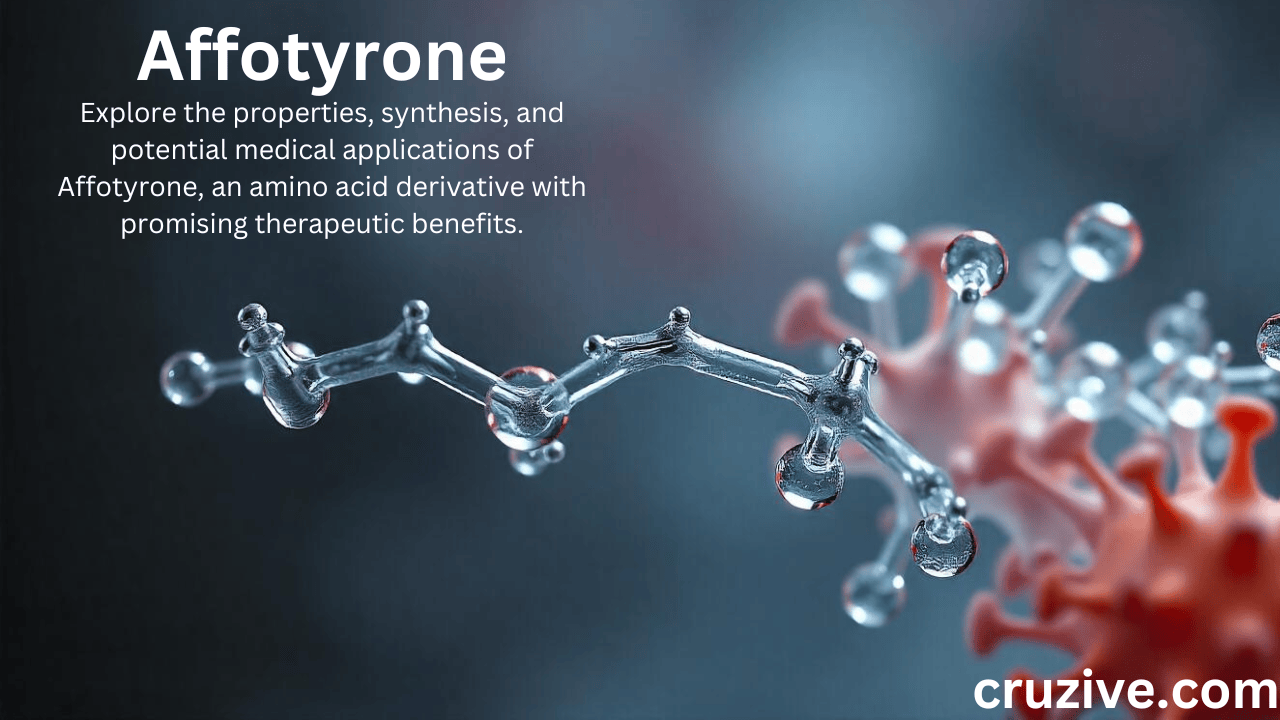In the vast landscape of biochemical compounds, amino acid derivatives have garnered significant attention due to their diverse roles in physiological processes and therapeutic applications. One such derivative, Affotyrone, has emerged as a compound of interest among researchers and healthcare professionals. This article delves into the properties, synthesis, and potential medical applications of Affotyrone, shedding light on its significance in modern medicine.
What is Affotyrone?
Affotyrone is a derivative of the amino acid tyrosine, which is one of the 20 standard amino acids utilized by cells to synthesize proteins. Tyrosine plays a pivotal role in protein synthesis and serves as a precursor for various neurotransmitters and hormones. By modifying the tyrosine molecule, Affotyrone exhibits unique properties that distinguish it from its parent compound, potentially offering novel therapeutic benefits.
Chemical Properties and Synthesis
The chemical structure of Affotyrone is characterized by modifications to the phenolic hydroxyl group of tyrosine, resulting in altered physicochemical properties. These modifications can influence the compound’s solubility, stability, and reactivity, which are crucial factors in its biological activity and therapeutic potential.
The synthesis of Affotyrone involves specific chemical reactions that modify the tyrosine molecule. These reactions are meticulously controlled to ensure the desired structural changes without compromising the integrity of the amino acid backbone. Advanced techniques in organic chemistry facilitate the efficient production of Affotyrone, making it accessible for research and potential clinical use.
Molecular structure of Affotyrone
As of now, specific details regarding the molecular structure of Affotyrone are not readily available in public or scientific databases. Affotyrone is described as a derivative of the amino acid tyrosine, implying it has a modified structure derived from the base tyrosine molecule. Tyrosine’s molecular formula is C9H11NO3, and its structure features an aromatic phenol group attached to a side chain of CH2 and NH2 groups.
For Affotyrone, modifications are likely made to the phenol group or side chain, altering its physical and chemical properties. These changes could involve:
- Substitutions on the Phenol Group: Adding or modifying functional groups like hydroxyl, carboxyl, or alkyl groups.
- Side-Chain Alterations: Adding or replacing atoms on the amino or carboxyl functional groups, potentially impacting reactivity or bonding.
If you’re conducting specific research or need precise structural details, consulting the latest scientific literature or databases such as PubChem or ChemSpider, or reaching out to researchers working on Affotyrone, would be the most reliable approach.
Would you like me to perform a more detailed search or create a speculative structure based on its general description?
Affronoye dietary supplement

Affronoye is a dietary supplement that has garnered attention for its potential health benefits. As with any supplement, it’s essential to understand its composition, purported advantages, and safety considerations.
Composition and Origin
Affronoye is formulated with a blend of natural ingredients, including vitamins, minerals, and herbal extracts. The specific components are selected to support various aspects of health and well-being.
Purported Health Benefits
Manufacturers of Affronoye claim that the supplement offers several health benefits, such as:
- Enhanced Cognitive Function: Ingredients in Affronoye are believed to support brain health and improve mental clarity.
- Mood Support: Certain herbal extracts in the supplement may help in maintaining a positive mood and reducing stress levels.
- Antioxidant Properties: The supplement contains components that act as antioxidants, potentially protecting cells from oxidative stress.
Medical Applications of Affotyrone
Affotyrone, a derivative of the amino acid tyrosine, exhibits unique properties that make it a promising candidate for various medical applications. Its structural modifications enable potential benefits in treating neurological, metabolic, and inflammatory disorders. Below are the key medical applications being explored for Affotyrone:
Affotyrone’s unique structure imparts properties that may be harnessed for various medical applications:
1. Neurological Disorders
Affotyrone’s link to tyrosine metabolism makes it a candidate for addressing neurological issues, as tyrosine is a precursor to neurotransmitters like dopamine, norepinephrine, and epinephrine. This association opens doors for treatments in:
- Parkinson’s Disease: Affotyrone may enhance dopamine synthesis, potentially alleviating motor and cognitive symptoms associated with dopamine deficits.
- Depression and Anxiety Disorders: By modulating neurotransmitter levels, Affotyrone could play a role in mood regulation and stress management.
- Neuroprotection: Its potential antioxidant properties may protect neural tissues from oxidative damage, a key factor in neurodegenerative diseases.
2. Antioxidant Therapy
Oxidative stress is implicated in the progression of many chronic diseases. The structural modifications in Affotyrone may enhance its ability to neutralize free radicals, offering benefits such as:
- Cellular Protection: Reducing oxidative damage to cells and tissues, which is particularly valuable in cardiovascular diseases and neurodegeneration.
- Anti-Aging Applications: Potential use in therapies aimed at slowing the cellular aging process.
3. Anti-Inflammatory Properties
Chronic inflammation is at the root of many diseases, including autoimmune disorders, arthritis, and cardiovascular conditions. Affotyrone’s structural properties suggest potential in:
- Reducing Chronic Inflammation: Modulating inflammatory pathways to provide relief in conditions such as rheumatoid arthritis or inflammatory bowel disease.
- Immune Regulation: Supporting the balance of pro- and anti-inflammatory responses, beneficial for autoimmune diseases.
4. Metabolic Regulation
Affotyrone’s impact on metabolic pathways presents promising applications in:
- Diabetes Management: Potential to improve insulin sensitivity or regulate glucose metabolism.
- Obesity Treatments: By influencing energy pathways, Affotyrone could assist in weight management.
- Thyroid Function: Tyrosine derivatives are known precursors for thyroid hormones; Affotyrone might offer improved modulation of thyroid hormone synthesis.
5. Cancer Research
Although still in its infancy, studies suggest Affotyrone may hold anti-cancer properties:
- Cytotoxic Effects on Tumors: By influencing specific metabolic pathways, it might inhibit tumor growth.
- Adjunct Therapy: Enhancing the efficacy of existing cancer treatments while protecting healthy tissues from oxidative damage caused by chemotherapy or radiation.
6. Wound Healing and Tissue Repair
Affotyrone’s potential role in promoting tissue regeneration makes it an exciting prospect for:
- Wound Care: Enhancing healing processes through antioxidant and anti-inflammatory effects.
- Chronic Wound Management: Particularly useful in diabetic ulcers and other conditions with impaired healing.
7. Future Potential in Personalized Medicine
The versatility of Affotyrone positions it as a candidate for personalized medicine. Its molecular modifications could allow tailored therapies based on individual patient profiles, targeting specific conditions with minimal side effects.
Current Research and Future Directions
The scientific community is actively exploring Affotyrone’s pharmacokinetics, safety profile, and therapeutic efficacy. Clinical trials are essential to determine its potential benefits and any associated risks. Future research aims to elucidate the mechanisms by which Affotyron exerts its effects, optimize its synthesis for large-scale production, and explore its applications across various medical disciplines.
Conclusion
Affotyrone represents a promising frontier in the realm of amino acid derivatives, with potential applications spanning neurology, antioxidative therapy, and metabolic regulation. While research is still in its nascent stages, the unique properties of Affotyron warrant further investigation to fully understand and harness its therapeutic potential. As science advances, Affotyron may emerge as a valuable tool in the arsenal of compounds aimed at improving human health.
FAQs
What is Affotyrone?
Affotyrone is a derivative of the amino acid tyrosine, modified to exhibit unique properties that may have therapeutic applications in fields such as neurology, antioxidant therapy, and metabolic regulation.
How is Affotyron synthesized?
Affotyron is synthesized through chemical reactions that modify the tyrosine molecule, specifically targeting the phenolic hydroxyl group. This process is carefully controlled to maintain the integrity of the amino acid structure.
What are the potential medical applications of Affotyron?
Affotyron shows promise in treating neurological disorders like Parkinson’s disease, managing oxidative stress, reducing inflammation, and regulating metabolic processes, including those related to diabetes and obesity.
Is Affotyron safe for clinical use?
While research on Affotyron is still ongoing, initial studies are focused on understanding its safety profile and pharmacokinetics. Clinical trials are needed to establish its safety and efficacy for therapeutic use.
What makes Affotyron different from tyrosine?
Affotyron is a modified form of tyrosine, with structural changes that alter its biochemical properties. These changes may enhance its functionality in therapeutic applications compared to unmodified tyrosine.
Are there any ongoing clinical trials for Affotyron?
Yes, researchers are actively studying Affotyrone in preclinical and clinical settings to determine its potential benefits, mechanisms of action, and suitability for medical use.
How does Affotyron help in neurological disorders?
Affotyron may influence the synthesis and regulation of neurotransmitters like dopamine and norepinephrine, which play crucial roles in neurological health. This makes it a candidate for conditions like Parkinson’s disease and depression.










